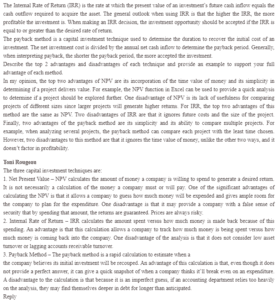IRR and NPV
Responding to Diandra M.
Hello Diandra,
I enjoyed reading your post on IRR and NPV. I want to add some information regarding the pros and cons. The NPV provides the investment’s return in dollars to add to the advantages and disadvantages. IRR may not be very accurate for predicting the profitability or cost of the entire project. The assumption that all cash flows will be reinvested back into the task at a similar rate is misleading. Furthermore, if one uses IRR to make investment decisions exclusively exclusively, it can be tricky (CFI Education Inc., 2022). Based on the disadvantages, combining multiple methods when analyzing a project’s returns is advisable. This increases the accuracy of the result and facilitates better decision-making in investments. Great post!
Get in touch with us at eminencepapers.com for any assistance.
Reference
CFI Education Inc. (2022). Internal Rate of Return (IRR). Retrieved from https://corporatefinanceinstitute.com/resources/knowledge/finance/internal-rate-return-irr/
Responding to Toni Rougeau
Hello Toni,
I like the presentation of your post. It clearly explains the three methods, making it easy to understand. I agree that the NPV may grant an organization false security of returns on their investment. In addition, a reasonably long list must be provided, and the evaluation must be sensitive to any minimal changes in the drivers and assumptions. On the positive side, NPV considers several aspects, including the timing of various cash flows. This allows the organization or business to project a more explicit expectation of the future and plan appropriately.
Similarly, the IRR does not show an accurate position of the organization’s investment due to the assumption that all cash flow will be reinvested into the project at the same rate (CFI Education Inc., 2015). None of the three methods offers a failproof way of evaluating an investment. Therefore, it is wise to utilize multiple evaluation methods and increase the accuracy.
Reference
CFI Education Inc. (2015). Net Present Value (NPV). Retrieved from https://corporatefinanceinstitute.com/resources/knowledge/valuation/net-present-value-npv/
ORDER A PLAGIARISM-FREE PAPER HERE
We’ll write everything from scratch
Question
The Internal Rate of Return (IRR) is the rate at which the present value of an investment’s future cash inflow equals the cash outflow required to acquire the asset. The general outlook when using IRR is that the higher the IRR, the more profitable the investment is. When making an IRR decision, the investment opportunity should be accepted if the IRR is equal to or greater than the desired rate of return.

IRR and NPV
The payback method is a capital investment technique used to determine the duration to recover the initial cost of an investment. The net investment cost is divided by the annual net cash inflow to determine the payback period. Generally, when interpreting payback, the shorter the payback period, the more accepted the investment.
Describe each technique’s top 2 advantages and disadvantages and provide an example to support your full advantage of each method.
The top two advantages of NPV are its incorporation of the time value of money and its simplicity in determining if a project delivers value. For example, the NPV function in Excel can provide a quick analysis to determine if a project should be explored further. One disadvantage of NPV is its lack of usefulness for comparing projects of different sizes since larger projects will generate higher returns. For IRR, the top two advantages of this method are the same as NPV. Two disadvantages of IRR are that it ignores future costs and the size of the project. Finally, two advantages of the payback method are its simplicity and its ability to compare multiple projects. For example, when analyzing several projects, the payback method can compare each project with the least time chosen. However, two disadvantages to this method are that it ignores the time value of money, unlike the other two ways, and it doesn’t factor in profitability.
Toni Rougeau
The three capital investment techniques are:
1. Net Present Value – NPV calculates the amount of money a company is willing to spend to generate a desired return. It is not necessarily a calculation of the money a company must or will pay. One of the significant advantages of calculating the NPV is that it allows a company to guess how much money will be expended and gives ample room for the company to plan for the expenditure. One disadvantage is that it may provide a company with a false sense of security that by spending that amount, the returns are guaranteed. Prices are always risky.
2. Internal Rate of Return – IRR calculates the amount spent versus how much money is made back because of this spending. An advantage is that this calculation allows a company to track how much money is being spent versus how much money is coming back into the company. One disadvantage of the analysis is that it does not consider low asset turnover or lagging accounts receivable turnover.
3. Payback Method – The payback method is a rapid calculation to estimate when a
the company believes its initial investment will be recouped. An advantage of this calculation is that, even though it does not provide a perfect answer, it can give a quick snapshot of when a company thinks it’ll break even on an expenditure. A disadvantage to the calculation is that because it is an imperfect guess, if an accounting department relies too heavily on the analysis, they may find themselves deeper in debt for longer than anticipated.
Reply

